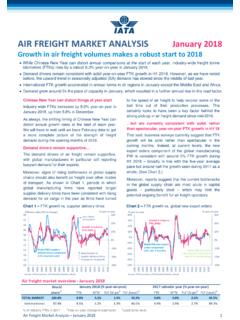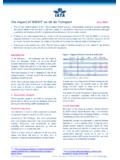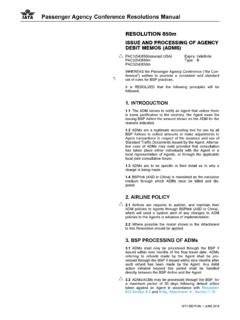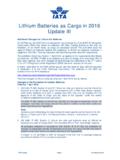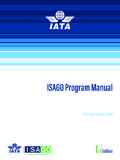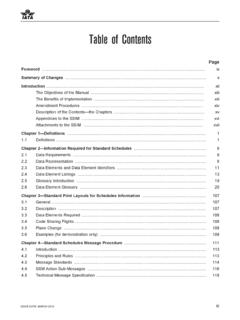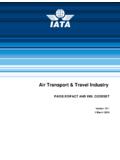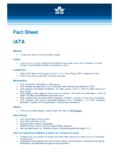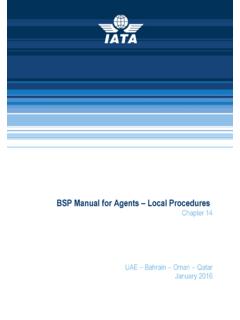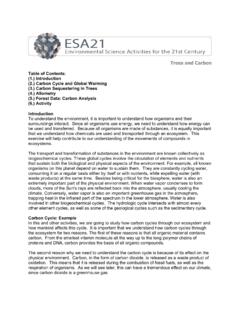Transcription of Sustainable Aviation Fuels Fact Sheet 5
1 Sustainable Aviation Fuels December 2018 Sustainable Aviation Fuels Fact Sheet 5 SAF - SUSTAINABILITY CONSIDERATIONS Sustainability, in the context of SAF, may be broadly defined as conserving an ecological balance by avoiding depletion of natural resources. While airlines may use any SAF that meets the technical certification criteria, those certifications (ASTM D7566, DefStan 91-91, etc.) do not guarantee sustainability; they only describe the physical properties of the fuel itself. There are multiple reasons that an airline should seek to use SAF that has also been certified Sustainable , including: Simply using SAF does not necessarily reduce overall carbon emissions; a SAF must demonstrate a net carbon reduction through a lifecycle analysis (LCA), which is an essential element of sustainability certification.
2 The property of achieving a net carbon emissions reduction is a main motivation for using SAF in order to meet the Aviation industry s ambitious climate goals. Governmental financial incentives for SAF production or use are typically only available for SAF meeting sustainability criteria. Prominent examples include the US Renewable Fuels Standard (RFS2), the EU Emissions Trading Scheme (EU ETS), the EU Renewable Energy Directive (RED) and CORSIA. Details are given in Chapter 5; In the US and EU, only certified SAF may contribute to government mandates for renewable fuel volumes or quotas. Elements of sustainability schemes There are multiple criteria that are taken into consideration when determining the sustainability of a SAF.
3 Some typical sustainability metrics are as follows: Lifecycle carbon emissions Fertilizer and pesticide management Direct and indirect land use change Waste management Authorized land categories Invasive species controls Water, air and soil considerations Verification Certificate of Sustainability (CoS): This is typically issued by an accredited organization certifying that SAF from a specific origin and produced using a specific processing pathway meets the criteria of a given sustainability standard, even if it does not present all characteristics of a certificate in a strict sense. There are multiple organizations that can assess the production of a SAF to determine if it meets sufficient criteria to be considered Sustainable .
4 However, there is much variability between the criteria and certification methods applied by each of these organizations. A coalition of 28 airlines have formed a group called the Sustainable Aviation Fuel Users Group (SAFUG). The SAFUG group of airlines have made a pledge to only use SAF that meets criteria consistent with internationally recognised standards such as those of the Round Table on Sustainable Biomaterials (RSB). The key areas of sustainability that the RSB principles and criteria address can be seen below. The full SAFUG pledge can be found: Lifecycle greenhouse gas emissions: Relative to fossil Fuels , sustainably-produced, unconventional, jet fuel results in a reduction in carbon dioxide (CO2) emissions across its life cycle.
5 carbon dioxide absorbed by plants during the growth of biomass is roughly equivalent to the amount of carbon dioxide produced when the fuel is burned in a combustion engine, which is simply returned to the atmosphere. This would allow the SAF to be approximately carbon -neutral over its life cycle. However, there are emissions produced during the production of SAF, from the equipment needed to grow the crop, transport the raw goods, refine the fuel and so on. When these elements are accounted for, the use of Sustainable Aviation fuel has been shown to provide significant reductions in overall CO2 lifecycle emissions compared to fossil Fuels , up to 80% in some cases.
6 Furthermore, SAF contains fewer impurities (such as sulphur), which enables an even greater reduction in sulphur dioxide and particulate matter emissions than present technology has achieved. In the case of SAF produced from municipal waste, the environmental gains are derived both from avoiding petroleum use and from the fact that the waste would be otherwise left to decompose in landfill sites, producing no further benefits, rather than being used to power a commercial flight, which would otherwise be powered by unsustainable, fossil-based fuel. For further information or additional clarification please visit website: Or contact Robert Boyd
